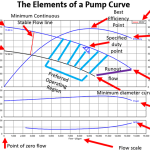The Affinity Laws are mathematical expressions that define changes in pump capacity, head, and BHP when a change is made to pump speed, impeller diameter, or both. According to the Affinity Laws:
Capacity (Q) changes in direct proportion to impeller diameter D ratio, or to speed N ratio:
Q2 = Q1 x [D2/D1]
Eq. (16)
Q2 = Q1 x [N2/N1]
Eq. (17)
Head (H) changes in direct proportion to the square of impeller diameter D ratio, or the square of speed N ratio:
H2 = H1 x [D2/D1]2
Eq. (18)
H2 = H1 x [N2/N1]2
Eq. (19)
BHP changes in direct proportion to the cube of impeller diameter ratio, or the cube of speed ratio:
BHP2 = BHP1 x [D2/D1]3
Eq. (20)
BHP2 = BHP1 x [N2/N1]3
Eq. (21)
Where the subscript: 1 refers to initial condition, 2 refer to new condition.
If changes are made to both impeller diameter and pump speed the equations can be combined to:
Q2 = Q1 x [(D2 x N2)/(D1 x N1)]
Eq. (22)
H2 = H1 x [(D2 x N2)/(D1 x N1)]2
Eq. (23)
BHP2 = BHP1 x [(D2 x N2)/(D1 x N1)]3
Eq. (24)
These equations are used to hand-calculate the impeller trim diameter from a given pump performance curve at a bigger diameter.
The Affinity Laws are valid only under conditions of constant efficiency


